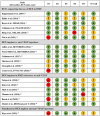Safety and Efficacy of Dexamethasone Intravitreal Implant Given Either First-Line or Second-Line in Diabetic Macular Edema
- PMID: 38106365
- PMCID: PMC10725633
- DOI: 10.2147/PPA.S427209
Safety and Efficacy of Dexamethasone Intravitreal Implant Given Either First-Line or Second-Line in Diabetic Macular Edema
Abstract
Diabetic macular edema (DME) is a common sight-threatening complication of diabetic retinopathy (DR) and the leading cause of severe visual impairment among the working-age population. Several therapeutic options are available for the management of DME, including intravitreal corticosteroids. They have been traditionally used as second-line treatment, due to the risk of intraocular pressure increase and cataract-related adverse events. However, attention has recently been focused on the primary or early use of intravitreal corticosteroids, due to growing evidence of the crucial role of inflammation in the pathogenesis of DME. Furthermore, intravitreal steroid implants offer the additional advantage of a longer duration of action compared to anti-vascular endothelial growth factor agents (anti-VEGF). This review aims to summarize the available evidence on the efficacy and safety profile of dexamethasone (DEX) intravitreal implant, with a specific focus on clinical scenarios in which it might be considered or even preferred as first-line treatment option by adequate selection of patients, considering both advantages and possible adverse events. Patients with contraindications to anti-VEGF, DME with high inflammatory OCT biomarkers, pseudophakic patients and phakic patients' candidates to cataract surgery as well as vitrectomized eyes may all benefit from first-line DEX implant. Additionally, DME not responders to anti-VEGF should be considered for a switch to DEX implant and a combination therapy of DEX implant and anti-VEGF could be a valid option in severe and persistent DME.
Keywords: DEX implant; DME; Ozurdex; corticosteroids; dexamethasone intravitreal implant; diabetic macular edema.
© 2023 Taloni et al.
Conflict of interest statement
The authors report no conflicts of interest in this work.
Figures



References
Publication types
LinkOut - more resources
Full Text Sources

